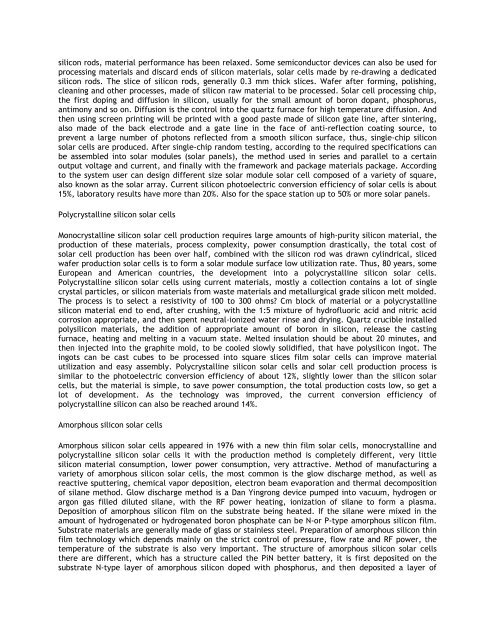How Do Solar Panel Work? A solar panel is a ... - Digital Consummate
How Do Solar Panel Work? A solar panel is a ... - Digital Consummate
How Do Solar Panel Work? A solar panel is a ... - Digital Consummate
Create successful ePaper yourself
Turn your PDF publications into a flip-book with our unique Google optimized e-Paper software.
silicon rods, material performance has been relaxed. Some semiconductor devices can also be used for<br />
processing materials and d<strong>is</strong>card ends of silicon materials, <strong>solar</strong> cells made by re-drawing a dedicated<br />
silicon rods. The slice of silicon rods, generally 0.3 mm thick slices. Wafer after forming, pol<strong>is</strong>hing,<br />
cleaning and other processes, made of silicon raw material to be processed. <strong>Solar</strong> cell processing chip,<br />
the first doping and diffusion in silicon, usually for the small amount of boron dopant, phosphorus,<br />
antimony and so on. Diffusion <strong>is</strong> the control into the quartz furnace for high temperature diffusion. And<br />
then using screen printing will be printed with a good paste made of silicon gate line, after sintering,<br />
also made of the back electrode and a gate line in the face of anti-reflection coating source, to<br />
prevent a large number of photons reflected from a smooth silicon surface, thus, single-chip silicon<br />
<strong>solar</strong> cells are produced. After single-chip random testing, according to the required specifications can<br />
be assembled into <strong>solar</strong> modules (<strong>solar</strong> <strong>panel</strong>s), the method used in series and parallel to a certain<br />
output voltage and current, and finally with the framework and package materials package. According<br />
to the system user can design different size <strong>solar</strong> module <strong>solar</strong> cell composed of a variety of square,<br />
also known as the <strong>solar</strong> array. Current silicon photoelectric conversion efficiency of <strong>solar</strong> cells <strong>is</strong> about<br />
15%, laboratory results have more than 20%. Also for the space station up to 50% or more <strong>solar</strong> <strong>panel</strong>s.<br />
Polycrystalline silicon <strong>solar</strong> cells<br />
Monocrystalline silicon <strong>solar</strong> cell production requires large amounts of high-purity silicon material, the<br />
production of these materials, process complexity, power consumption drastically, the total cost of<br />
<strong>solar</strong> cell production has been over half, combined with the silicon rod was drawn cylindrical, sliced<br />
wafer production <strong>solar</strong> cells <strong>is</strong> to form a <strong>solar</strong> module surface low utilization rate. Thus, 80 years, some<br />
European and American countries, the development into a polycrystalline silicon <strong>solar</strong> cells.<br />
Polycrystalline silicon <strong>solar</strong> cells using current materials, mostly a collection contains a lot of single<br />
crystal particles, or silicon materials from waste materials and metallurgical grade silicon melt molded.<br />
The process <strong>is</strong> to select a res<strong>is</strong>tivity of 100 to 300 ohms? Cm block of material or a polycrystalline<br />
silicon material end to end, after crushing, with the 1:5 mixture of hydrofluoric acid and nitric acid<br />
corrosion appropriate, and then spent neutral-ionized water rinse and drying. Quartz crucible installed<br />
polysilicon materials, the addition of appropriate amount of boron in silicon, release the casting<br />
furnace, heating and melting in a vacuum state. Melted insulation should be about 20 minutes, and<br />
then injected into the graphite mold, to be cooled slowly solidified, that have polysilicon ingot. The<br />
ingots can be cast cubes to be processed into square slices film <strong>solar</strong> cells can improve material<br />
utilization and easy assembly. Polycrystalline silicon <strong>solar</strong> cells and <strong>solar</strong> cell production process <strong>is</strong><br />
similar to the photoelectric conversion efficiency of about 12%, slightly lower than the silicon <strong>solar</strong><br />
cells, but the material <strong>is</strong> simple, to save power consumption, the total production costs low, so get a<br />
lot of development. As the technology was improved, the current conversion efficiency of<br />
polycrystalline silicon can also be reached around 14%.<br />
Amorphous silicon <strong>solar</strong> cells<br />
Amorphous silicon <strong>solar</strong> cells appeared in 1976 with a new thin film <strong>solar</strong> cells, monocrystalline and<br />
polycrystalline silicon <strong>solar</strong> cells it with the production method <strong>is</strong> completely different, very little<br />
silicon material consumption, lower power consumption, very attractive. Method of manufacturing a<br />
variety of amorphous silicon <strong>solar</strong> cells, the most common <strong>is</strong> the glow d<strong>is</strong>charge method, as well as<br />
reactive sputtering, chemical vapor deposition, electron beam evaporation and thermal decomposition<br />
of silane method. Glow d<strong>is</strong>charge method <strong>is</strong> a Dan Yingrong device pumped into vacuum, hydrogen or<br />
argon gas filled diluted silane, with the RF power heating, ionization of silane to form a plasma.<br />
Deposition of amorphous silicon film on the substrate being heated. If the silane were mixed in the<br />
amount of hydrogenated or hydrogenated boron phosphate can be N-or P-type amorphous silicon film.<br />
Substrate materials are generally made of glass or stainless steel. Preparation of amorphous silicon thin<br />
film technology which depends mainly on the strict control of pressure, flow rate and RF power, the<br />
temperature of the substrate <strong>is</strong> also very important. The structure of amorphous silicon <strong>solar</strong> cells<br />
there are different, which has a structure called the PiN better battery, it <strong>is</strong> first deposited on the<br />
substrate N-type layer of amorphous silicon doped with phosphorus, and then deposited a layer of



